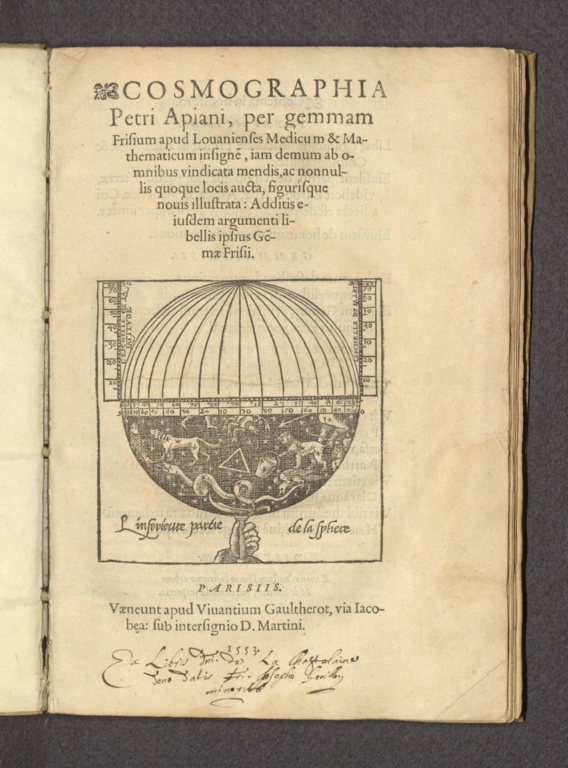COLLECTION NAME:
David Rumsey Historical Map Collection
Record
Author:
Apian, Peter, 1495-1552
Author:
Gemma, Frisius, 1508-1555
Author:
Gaultherot, Vivant
Date:
1553
Short Title:
Title: Cosmographica Petri Apiani ...
Publisher:
Viuantium Gaultherot
Publisher Location:
Paris
Type:
Title Page
Type:
Celestial Map
Obj Height cm:
25
Obj Width cm:
17
Note:
Title page to Cosmographica Petri Apiani. Includes title and imprint. Title translates to: Title translates to: Apian’s Cosmography, by means of a physical & mathematical … With a celestial woodcut map, entitled "L inferieure partie de la sphere" [= The lower part of the sphere], in the shape of a globe, held by a hand. Map includes illustrations of constellations, longitudinal lines and two bar scales. With inscription, in ink, beneath imprint.
Subject:
Astronomy
Subject:
Data Visualization
Full Title:
(Title Page to) Cosmographica Petri Apiani, per gemmam Frisium apud Lovanienses Medicum & Mathematicum insignẽ, iam demum ab omnibus vindicata mendis, ac nonnullis quoque locis aucta, figurisque nouis illustrata: Additis eiusdem argumenti libellis ipsius Gẽmæ Frisii. Parisiis. Væneunt apud Viuantium Gaultherot, via Iacobę: sub intersignio D. Martini. 1553.
List No:
14336.003
Series No:
3
Publication Author:
Apian, Peter, 1495-1552
Publication Author:
Gemma, Frisius, 1508-1555
Publication Author:
Gaultherot, Vivant
Pub Date:
1553
Pub Title:
Cosmographica Petri Apiani, per gemmam Frisium apud Lovanienses Medicum & Mathematicum insignẽ, iam demum ab omnibus vindicata mendis, ac nonnullis quoque locis aucta, figurisque nouis illustrata: Additis eiusdem argumenti libellis ipsius Gẽmæ Frisii. Parisiis. Væneunt apud Viuantium Gaultherot, via Iacobę: sub intersignio D. Martini. 1553.
Pub Note:
Cosmographica Petri Apiani, by Peter Apian (1495-1552). Parisian edition, published by Viuantium Gaultherot and dated 1553 on the title page (1551 on colophon). With corrections and additions by the cartographer Gemma Frisius. Bound in vellum with sewn binding. Handwritten annotations, in ink, on front cover, including: Ex Libris ... Josephi Guillon. Spine title: Apiani. Cosmograph. Collation: 4° : [2], 1-30, 35-74, [1]; signed A-H, K-4. With 1 double leaf of plates featuring a woodcut world map, which presents one of the most emblematic representations of South America in the sixteenth century, with new details contributed by Frisius. The text contains 26 maps of the terrestrial globe, moon, sun and other stars. In addition, 10 diagrams and 7 illustrations provide further information on astronomy, including the demonstration of astronomical instruments. Nautical cosmography is central to the work, as Apian was a pioneer in determining longitude according to the movement of the moon and stars. Including four volvelles, or turning dials, which provide information on the position and movement of celestial bodies. Inspired by both the Renaissance cartographer Johann Schoner and by Ptolemy, Cosmographica is a major work of Apian, a German cartographer, mathematician and astronomer who published significant works on astronomy, geography and cosmography - the study of the earth and its position in the universe. Apian was a pioneer in astronomical and geographical instrumentation, and one of the most successful popularizers of these subjects during the sixteenth century. He studied mathematics and astronomy in Leipzig and Vienna, and quickly established a reputation as an outstanding mathematician. Apian’s first major work, Cosmographia seu descriptio totius orbis (1524), was based on Ptolemy. Starting with the distinction between cosmography, geography, and chorography, and using an ingenious and simple diagram, the book defines terrestrial grids; describes the use of maps and simple surveying; defines weather and climate; and provides thumbnail sketches of the continents. In its later form, as modified by Gemma Frisius, the Cosmographia was one of the most popular texts of the time and was translated into all major European languages. The success of this and his previous works led to Apian’s appointment as professor of mathematics at the University of Ingolstadt, where he remained until his death. In honor of his scientific contributions, he was knighted by Charles V for the Germanic Empire. The success of Cosmographia may, in part, be attributable to its fantastical passages about strange peoples and foreign places, including a brief section on the newly-discovered continent of America. For the most part however, Cosmographia is a practical book, intended to introduce laymen to concepts in astronomy, geography, geometry, surveying, and navigation. It provides detailed information on the structure of the universe and how one might navigate through it by using various instruments and devices and by taking measured observations of the heavens and the Earth. To accomplish these ends, Cosmographia was lavishly illustrated with maps, charts, and diagrams. In these illustrations we see a Ptolemaic solar system dominated by the Earth and Moon, with the Sun orbiting somewhere between Venus and Mars. We see various phases of a lunar eclipse. The armillary sphere — an ornate, mechanical model of the cosmos — appears several times within the text. In the cordiform map, which first appeared in the 1544 edition, we see North America, a thin sliver of land off the coast of Asia labeled Baccalearum (land of the cod), floating within an otherwise recognizable map of the earth while the wind gods blow in from the margins. Perhaps most famously, we see volvelles. Popularized during the late middle ages and used in both scientific manuscripts and early printed books, volvelles are paper (or parchment) devices made of concentric disks that act like dials. The disks can be rotated into different configurations in order to make various calculations. They were usually intended for practical use, and Apianus’ volvelles (along with those added by Gemma Frisius) helped readers to apply geometric principles to navigation and practical geography and to understand the workings of the solar system. Adams, A 1281; Van Ortroy, 44; Mortimer 27; Murray, 15; Shirley, 82; Sabin, 1749.
Pub List No:
14336.000
Pub Type:
World Atlas
Pub Type:
Celestial Atlas
Pub Height cm:
25
Pub Width cm:
17
Image No:
14336003.jp2
Authors:
Apian, Peter, 1495-1552; Gemma, Frisius, 1508-1555; Gaultherot, Vivant
